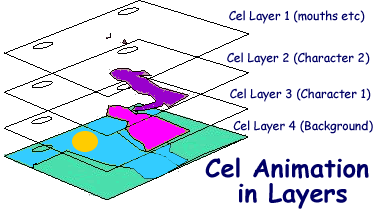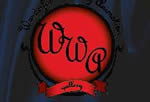Handpainted cel methodWhen an animation is made by hand each frame design is called a 'cel'.
The moving characters' outlines are drawn on cels and laid over a cel with a static background drawing on it.The film cels are therefore constructed in layers. This reduces the number of times the background image has to be redrawn and enables studios to split up the production process to different specialised teams.
Using this way to animate has made it possible to produce films much more cost-effectively and quickly. The invention of the technique is generally attributed to Earl Hurd, who patented the process in 1914. The outline of the images are drawn on the back of the cel by an artist. The colors are also painted on the back to eliminate brushstrokes. Traditionally, the outlines were hand-inked but now they are almost exclusively xerographed on. Another important breakthrough in cel animation was the development of the The Animation Photo Transfer, first seen in The Black Cauldron, released in 1985.
Disney stopped using cels in 1990 when Computer Animation Production System (CAPS) replaced this element in their animation process.It was much cheaper to draw directly into a computer program
|
|

Custom Search
 A cel (short for celluloid) is a transparent sheet on which objects are drawn and then painted. Actual celluloid (consisting of cellulose nitrate and camphor) was used during the first half of the 20th century, but it was flammable and dimensionally unstable and so it was largely replaced by cellulose acetate (like the sheets teachers use on OHPs).
A cel (short for celluloid) is a transparent sheet on which objects are drawn and then painted. Actual celluloid (consisting of cellulose nitrate and camphor) was used during the first half of the 20th century, but it was flammable and dimensionally unstable and so it was largely replaced by cellulose acetate (like the sheets teachers use on OHPs). 


